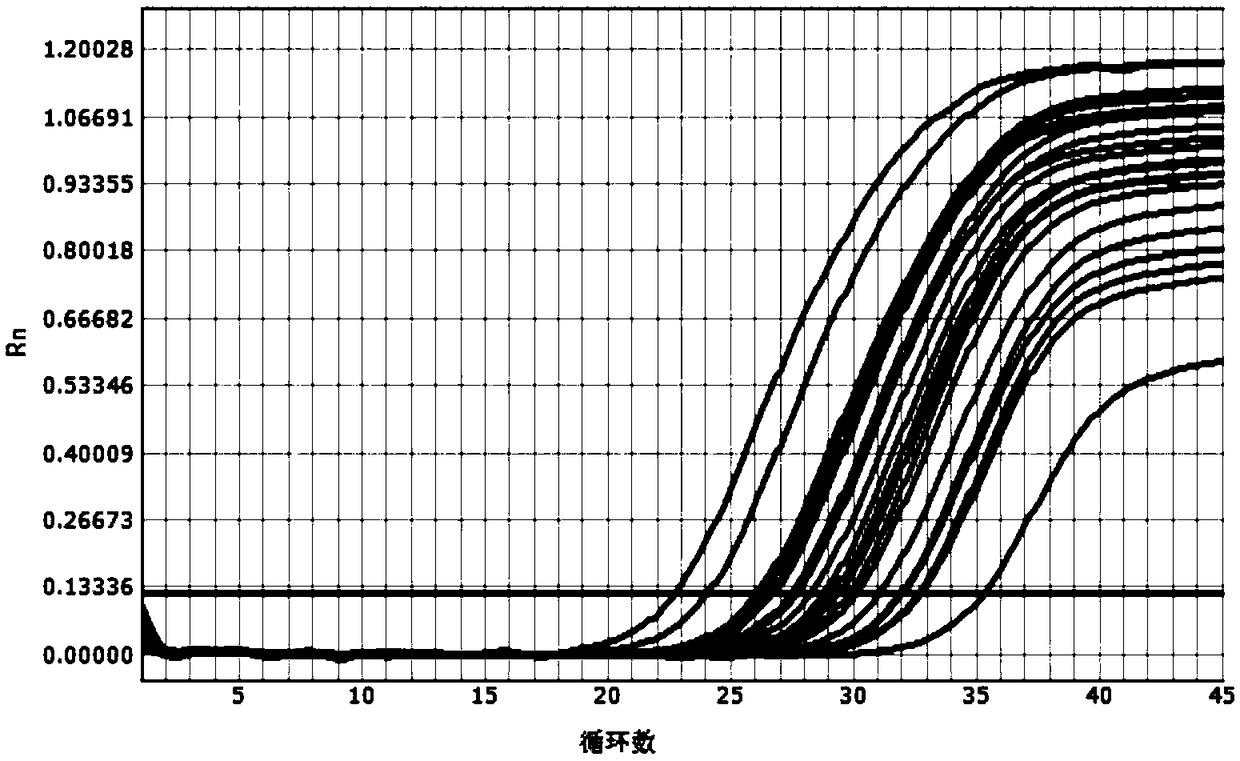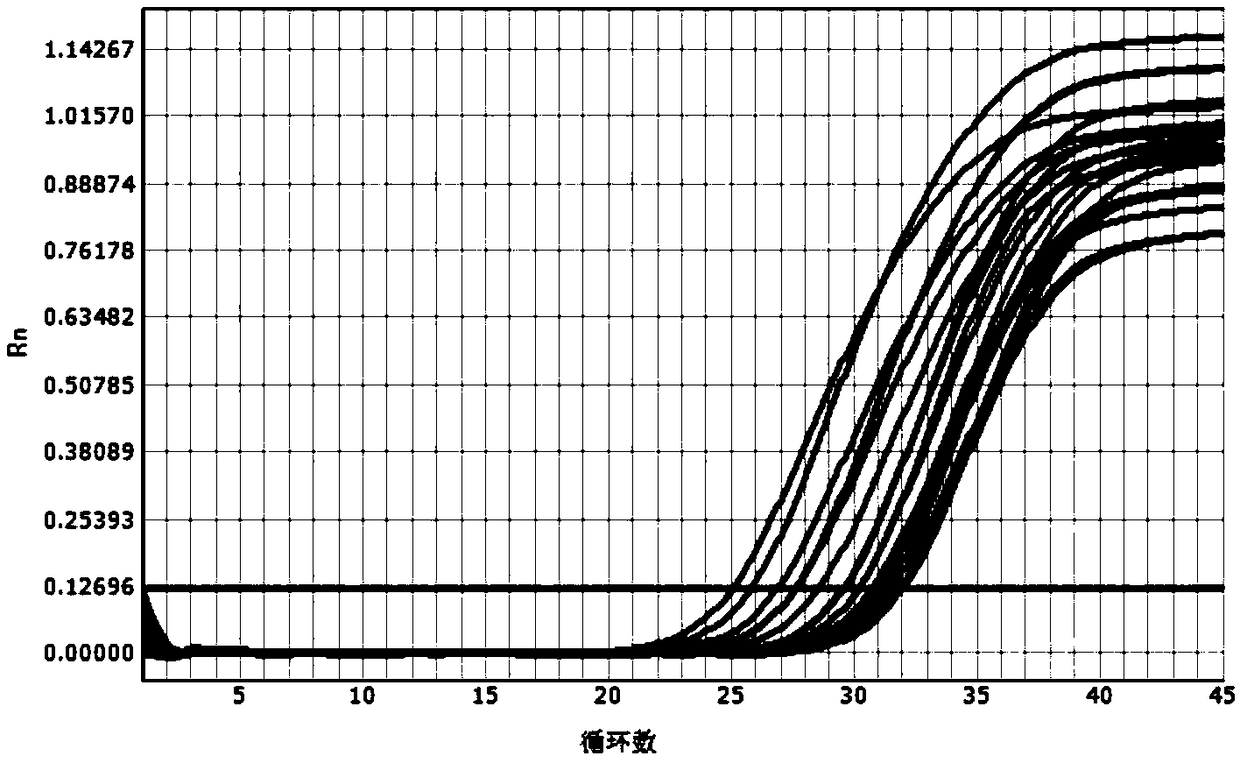Nucleic acid releasing agent, nucleic acid PCR (polymerase chain reaction) amplification method and PCR amplification kit
A nucleic acid release agent and nucleic acid technology, applied in the field of molecular biology, can solve problems such as instability, and achieve the effects of preventing degradation, good repeatability, and high detection sensitivity
- Summary
- Abstract
- Description
- Claims
- Application Information
AI Technical Summary
Problems solved by technology
Method used
Image
Examples
Embodiment 1~25
[0076] Embodiments 1-25: Prepare 25 parts of enterovirus throat swab samples (virus preservation solution matrix), take 100 μ L samples respectively and centrifuge at 12000 rpm / min for 10 min, discard the supernatant and add 50 μ L nucleic acid release agent, let stand for 10 min, and then Mix 10 μL with 40 μL PCR reaction solution for real-time fluorescent quantitative PCR amplification. The amplification curve is as follows: figure 1 shown. The nucleic acid release agents used in Examples 1-25 include Tris-HCl, sodium chloride, potassium chloride, Tween 20, Triton X-100, ethylphenyl polyethylene glycol, betaine, bovine serum albumin, Proteinase K, Lithium Lauryl Sulfate and Sodium Hydroxide. Wherein, the molar concentration of Tris-HCl is 0.5mM, the molar concentration of sodium chloride is 500mM, the volume percentage of Tween 20 is 0.1%, the volume percentage of Triton X-100 is 3%, ethylphenyl polyethylene glycol The volume percentage of diol is 0.1%, the mass concentrat...
Embodiment 26~50
[0088] Examples 26-50: Prepare 25 respiratory tract sputum samples (normal saline matrix), take 5 μL samples respectively, add 5 μL nucleic acid release agent, let stand for 10 minutes, then add 40 μL PCR reaction solution and mix for real-time fluorescence quantitative PCR amplification, amplification curve like figure 2 shown. The nucleic acid release agents used include Tris-HCl, sodium chloride, potassium chloride, Tween 20, Triton X-100, ethylphenyl polyethylene glycol, betaine, bovine serum albumin, proteinase K, dodecyl Lithium Alkyl Sulfate and Sodium Hydroxide. Wherein, the molar concentration of Tris-HCl is 500mM, the molar concentration of sodium chloride is 20mM, the volume percentage of Tween 20 is 2%, the volume percentage of Triton X-100 is 0.1%, ethylphenyl polyethylene glycol The volume percentage of alcohol is 3%, the mass concentration of potassium chloride is 5mg / mL, the mass concentration of sodium hydroxide is 50mg / mL, the mass concentration of betaine...
Embodiment 51~90
[0100] Examples 51-90: Prepare 20 HCV serum samples, take 15 μL samples respectively, add 5 μL nucleic acid release agent, let stand for 10 minutes, then mix with 30 μL PCR reaction solution for real-time fluorescent quantitative PCR amplification, the amplification curve is as follows image 3 shown. The nucleic acid releasing agents used include Tris-HCl, sodium chloride, potassium chloride, Tween 20, Triton X-100, ethylphenyl polyethylene glycol, betaine, bovine serum albumin and sodium hydroxide. Wherein, the molar concentration of Tris-HCl is 200mM, the molar concentration of sodium chloride is 250mM, the volume percentage of Tween 20 is 1%, the volume percentage of Triton X-100 is 2%, ethylphenyl polyethylene glycol The volume percentage of alcohol is 2%, the mass concentration of potassium chloride is 9mg / mL, the mass concentration of sodium hydroxide is 25mg / mL, the mass concentration of betaine is 10mg / mL, and the mass concentration of bovine serum albumin is 60mg / mL....
PUM
 Login to View More
Login to View More Abstract
Description
Claims
Application Information
 Login to View More
Login to View More - R&D
- Intellectual Property
- Life Sciences
- Materials
- Tech Scout
- Unparalleled Data Quality
- Higher Quality Content
- 60% Fewer Hallucinations
Browse by: Latest US Patents, China's latest patents, Technical Efficacy Thesaurus, Application Domain, Technology Topic, Popular Technical Reports.
© 2025 PatSnap. All rights reserved.Legal|Privacy policy|Modern Slavery Act Transparency Statement|Sitemap|About US| Contact US: help@patsnap.com



